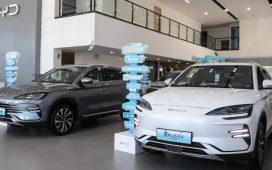The world’s biggest solar panel manufacturer has warned that Europe and the US risk slower decarbonisation of their economies if they restrict Chinese companies from their renewable energy supply chains.
China dominates solar manufacturing, accounting for more than 80 per cent of global production following decades of deep state support, rapid domestic demand growth and intense local competition.
But western political and industry leaders have called for greater diversity in supply amid a glut of Chinese imports, as well as expressing security fears about China-made components being used in critical infrastructure.
Dennis She, vice-president of Longi Green Energy Technology, which has around 20 per cent of the global market for photovoltaic modules, told the Financial Times that western countries would “at least slow down” their transitions away from fossil fuels if they were to cut back on Chinese solar supplies. He also warned that the cost of solar panels produced without Chinese involvement in countries like the US would be “double”.
Europe produces fewer than 3 per cent of the solar panels needed to reach its target of having 42.5 per cent of energy generated by renewable sources by 2030.
She said importing higher volumes from China would mean more “downstream” jobs beyond panel manufacturing, including in construction of new solar developments, as well as engineering, design and installation.
“You don’t need to kill most of the jobs from the downstream to protect 1 per cent [of the European jobs in solar manufacturing] — it doesn’t make sense,” he said.
The warnings come against a backdrop of rising western concern that Beijing’s subsidies for its clean tech industries — which also include wind, batteries and electric vehicles — have boosted Chinese manufacturing capacity far beyond the levels needed to meet domestic demand, leading to unfair trade practices as Chinese factories now flood international markets with exports.

Last month, a bipartisan group of US senators called on President Joe Biden to increase tariffs on Chinese-made solar imports. The heavily subsidised products were hurting American efforts to “reshore” domestic manufacturing, they said, adding that China’s overcapacity posed “an existential threat” to US energy security.
In response to western protectionism, China’s solar industry, which has weathered several rounds of tariffs from Europe and the US over the past 15 years, is increasingly expanding its manufacturing footprint closer to offshore customers, including in the US.
Yet some attempts to shift production to south-east Asia have been viewed in the US as a means to sidestep restrictions. Companies, including one Longi subsidiary, have been found guilty in the US of using foreign manufacturing to circumvent tariffs on Chinese-made components.
Longi makes most of its products in China, but also has factories in Vietnam and Malaysia’s southern state of Sarawak, and is planning a new factory in India.
To mitigate worsening geopolitical risk, She said, Longi is increasingly “trying to work with countries”, including through local joint venture partners, to set up more solar production capacity.
That includes the US, where the Shanghai-listed group has set up a joint venture with Invenergy in Ohio. Longi is also in talks to enter Saudi Arabia through a local partner.
However, to serve developing economies in regions including south-east Asia, Latin America and Africa, Longi is ramping up exports from China, She said, noting that about 1bn people in the world live without access to electricity.
“For the rest of the market, solar is a very good ‘gift from the gods’ . . . you have the solar [panels] from China, sunshine is your own sunshine,” he said.
Wood Mackenzie, an energy consultancy, has forecast that after investments worth more than $130bn last year alone, China is set to continue to lead solar technology and dominate more than three-quarters of the world’s solar polysilicon, wafer, cell and module manufacturing capacity for the next three years at least.
Last year, solar production costs in China fell by more than 40 per cent to around 15 cents per watt, compared to 30 cents in Europe and 40 cents in the US, according to Wood Mackenzie. The fall was driven in part by lower material costs and oversupply.
Longi’s current factory utilisation rate has fallen to between 70 and 80 per cent amid the glut, but it expects industry consolidation and demand growth in the next few years will help it gain market share and improve profitability.
“Everyone’s bleeding at this moment,” She said, adding that only players with sufficient scale like Longi were likely to survive.
“Small players, or new players from other industries, will disappear from the market . . . I can’t tell you the exact number, but tier-two, tier-three companies, most companies, actually, are at risk.”
Climate Capital

Where climate change meets business, markets and politics. Explore the FT’s coverage here.
Are you curious about the FT’s environmental sustainability commitments? Find out more about our science-based targets here









